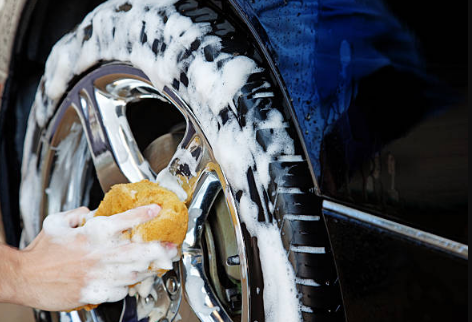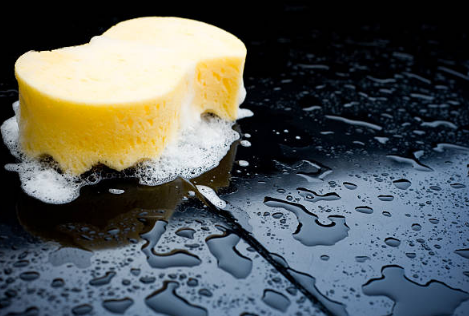You’re no stranger to cleaning cars, and you know it’s safe to wash the exterior. But should you also clean other parts of your car? What about those greasy, slimy, and dirty parts under the hood? Or what about those often overlooked spaces in the car? Learn which car parts are safe to clean at home and how to wash them effectively.

1. Tires
The tire is the only part of the vehicle that comes into direct contact with the ground. This means that tires can get all sorts of things like dirt, small rocks, and even nails! Washing your tires when you wash your car is a great way to keep them in good condition.
How to Clean Tires
The soapy water dripping from the body when washing the car is not enough to clean the tires. Luckily, cleaning tires is easy. Simply spray water on the tires to remove any loose dirt, scrub the tires (and wheels!) with a soft-bristled brush and soapy water. ), rinse off the soap, and wipe dry.
When cleaning your tires, it’s a good idea to do a quick check as well. Make sure the tires don’t have any visible punctures or tears, check the air pressure, and look at the tread depth. Tire tread depth must be more than 2/32″. In most states, tread depth is required by law to be more than 2/32″ to pass state inspection.
2. Chassis
The chassis is not a part of the vehicle that you look at often, and may not even look at it at all. Therefore, it is easy to ignore it when cleaning. Since the chassis is very close to the ground, it is easy to accumulate dirt and dust. Washing the chassis is especially important if you’re driving on a road sprinkled with salt, as sprinkling salt can cause corrosion and rust in your vehicle.
How to Clean the Chassis
The chassis is a difficult place to reach, especially when the car is low off the ground. One of the easiest ways to clean the chassis is to tilt the pressure washer or hose under the vehicle to remove all the dirt and grime. Or, drop off your car at a car wash and choose the chassis option!
If you’ve recently experienced an oil spill, you may be wondering how to remove oil from your chassis. Unfortunately, water alone can’t do the job. You’ll need to use a degreaser or similar product to remove the oil and keep the bottom of your car clean.
3. Engine Compartment
After wiping and waxing the hood, it’s time to inspect underneath the hood. Your engine compartment may not be exposed to wind and rain, but dust and debris will still get inside. In addition, you have to worry about possible leaks of oil and other fluids, creating a mess.
How to Properly Clean the Underneath the Hood of Your Car
The engine generates a lot of heat when it runs, so you’ll want to make sure that the engine compartment is completely cooled down before starting. Next, you’ll need to take some other precautions, including making sure all covers are secure and disconnecting the battery cable (check the battery cable removal procedure in the owner’s manual before disconnecting). You’ll also need to cover any electrical or sensitive parts such as batteries, ignition wires, engine control modules, and electrical connectors with plastic bags and electrical tape.
Use a vacuum cleaner or compressed air for a quick air clean (if using compressed air, wear eye protection to ensure that dust or debris does not get into your eyes). This will help remove any loose dirt before doing a deep clean. Depending on the condition of the engine compartment and whether you’ve had an oil spill recently, you may need to know how to remove grease from car parts. Similar to the chassis, degreasers will play an important role here.
Want to know how to clean the metal car parts you see in the cabin? Typically, metal and aluminum parts can be cleaned with a gentle scrub of a brush. After degreasing, scrubbing, and wiping, rinse the engine compartment and wipe it dry. You can use equipment such as an air compressor or leaf blower to speed up the cleaning process, but you should also leave the hood open for at least an hour to ensure that all parts are dry.
Note: Don’t forget to remove the temporary covering.

4. Battery Terminals
Once you’ve cleaned the rest of the engine compartment, you’ll need to check the battery terminals. Corrosion can accumulate on the terminals and negatively affect battery performance, so it is critical to clean this part.
How to Clean the Battery Terminals
In many vehicles, disconnecting the battery without a memory protector on hand can lead to potential problems, including resetting the drive monitor, disabling the navigation system, or even resetting engine control parameters, which can cause the engine to not run smoothly after reconnecting. Check your owner’s manual before disconnecting the battery cable to avoid these potential problems.
You can usually use what you already have in your home to clean the battery terminals. After consulting the owner’s manual and removing the battery cable, carefully wipe off the corrosion using a simple baking soda and water mixture and an old toothbrush. Rinse off any residue, dry the terminals, add a little Vaseline, and you’re good to go! Don’t forget to reconnect the battery!
5. Vents
You vacuum and wipe down the interior of your car, but have you ever paid attention to the vents? While an in-car air filter can effectively keep out debris, it may not always capture tiny dust particles that can build up in the vents.
How to Clean the Vents
For areas like vents and cup holders, you need to know how to clean small spaces in your car. There are items you can use, such as air compressors, old toothbrushes, cotton swabs, and paint brushes. For vents, try wrapping a microfiber cloth around a popsicle stick or butter knife and use it to clean between the slats.